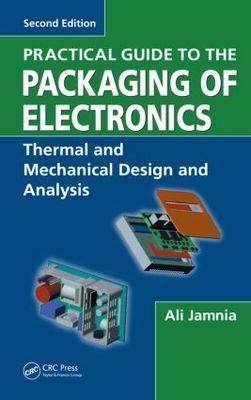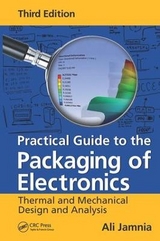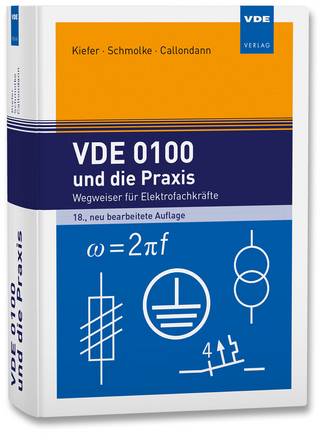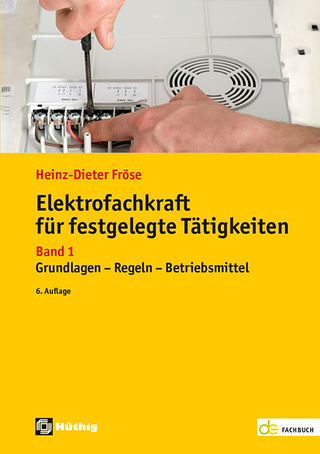
Practical Guide to the Packaging of Electronics, Second Edition
Crc Press Inc (Verlag)
978-1-4200-6531-2 (ISBN)
- Titel erscheint in neuer Auflage
- Artikel merken
As the demand for packaging more electronic capabilities into smaller packages rises, product developers must be more cognizant of how the system configuration will impact its performance. Practical Guide to the Packaging of Electronics: Second Edition, Thermal and Mechanical Design and Analysis provides a basic understanding of the issues that concern the field of electronics packaging. First published in 2003, this book has been extensively updated, includes more detail where needed, and provides additional segments for clarification.
This volume supplies a solid foundation for heat transfer, vibration, and life expectancy calculations. Topics discussed include various modes of heat removal, such as conduction, radiation, and convection; the impact of thermal stresses; vibration and the resultant stresses; shock management; mechanical, electrical, and chemically induced reliability; and more. Unlike many other available works, it neither assumes the reader’s familiarity with the subject nor is it so basic that the reader may lose interest.
Dr. Ali Jamnia has published a large number of engineering papers and presentations and is the holder of a number of patents and patent applications. He has been involved in the issues of electronics packaging since the early `90s and since 1995 has worked toward the development of innovative electronics systems to aid individuals with physical or cognitive disabilities.
By consulting this manual, engineers, program managers, and quality assurance managers involved in electronic systems gain a fundamental grasp of the issues involved in electronics packaging, learn how to define guidelines for a system’s design, develop the ability to identify reliability issues and concerns, and are able to conduct more complete analyses for the final design.
Jamnia & Associates, Chicago, Illinois, USA
INTRODUCTION
Issues in Electronics Packaging Design
Technical Management Issues
Electronics Design
Packaging / Enclosure Design
Reliability
BASIC HEAT TRANSFER: CONDUCTION, CONVECTION AND RADIATION
Basic Equations and Concepts
General Equations
Non Dimensional Groups
Nusselt Number
Grashof Number
Prandtl Number
Reynolds Number
CONDUCTIVE COOLING
Thermal Resistance
Sample Problem & Calculations
Resistance Network
Network Rules
Sample Problem & Calculations
Comparison with Exact Results
Assumptions
Temperature at Intermediate Points
Exercise: IC Temperature Determination
Heat Spreading
Thermal Modeling
Example
Applications
Junction-to-Junction Case Resistance
Contact Interface Resistance
Modeling the Interface
Exercise – Calculate the Component Temperature
First Approach
A Second Approach
A Third Approach
A Word on Edge Guides
2-D or 3-D Heat Conduction
Thermal Conductance
Example
RADIATION COOLING
Factors Influencing Radiation
Surface Properties
View Factor Calculations
View Factor Calculations In Electronics Packages
Examples and Illustrations
Electronics Packaging Problem
Flow in a Vertical Open-ended Channel
Cabinet Surface Temperature
First Approach
Second Approach
FUNDAMENTALS OF CONVECTION COOLING
Introduction
Flow Regimes, Types & Influences
Free (or natural) convection
Estimates of Heat Transfer Coefficient
Solution Procedure
High Altitudes
Board Spacing & Inlet-Outlet Openings
Design Tips
Cabinet Interior & Surface Temperature
Calculating Surface Temperature
Calculation of Internal Temperature
Calculation of Component Temperature
Fin Design
Basic Procedure
RF Cabinet Free Convection Cooling
Analytical Approach
Design Recommendations for This Example.
A More Exact Procedure
Forced Convection
Direct Flow System Design
Required Flow Rate
Board Spacing & Configurations
Flow Resistance
Flow Networks
Flow Rate Distribution Between Parallel Plates
Optimum Board Spacing and Heat flow
System’s Impedance Curve
Sample Problem
Fan-Selection, and Fan Laws
Fan Performance Curve
Fan Networks
More on Fan Performance Curves
Fan Laws
Component Hot Spot
Calculating hc Using Colburn Factor
Calculating hc Using Flow Rate
In-Direct Flow System Design
Resistance Network Representation
COMBINED MODES AS WELL AS TRANSIENT HEAT TRANSFER
Total System Resistance
Time Dependent Temperature Variation
Temperature Rise of an Electronic Module
BASICS OF VIBRATION AND ITS ISOLATION
Periodic and Harmonic Motions
Free Vibration
First Application
Example
Second Application
Mode Shapes
Damped Vibration
Impact of Damping
Forced Vibration
Engineering Applications
Dynamic Magnification Factor
Transmissibility
Phase Angle
Vibration Through Base Excitation
Example
Vibration Isolation
Example 1
Example 2
Applications to Electronics Enclosures
Maximum Deflection
Typical Transmissibility Values in Electronics Enclosures
Maximum Desired PCB Deflection
Random Vibration
Vibration Terminology
Peak Value
Average Value
Mean Square Value
Root Mean Square (RMS)
Decibel
Octave
Spectral Density
Solution Techniques For Random Vibration
Excitation Spectrum
Equipment Response
Vibrations Due to Acoustics And Noise
Multiple Degree of Freedom Systems
BASICS OF SHOCK MANAGEMENT
Pulse Shock Isolation
Example 1
Example 2
System without Isolators
System with Isolators
Velocity Shock Isolation
Example
Maximum Desired PCB Deflection
Equipment Design
INDUCED STRESSES
Forced Vibration
Sample Problem
Random Vibration
Probability of Failure
Example
Shock Environment
THE FINITE ELEMENT METHODS
Some Basic Definitions
THE FINITE ELEMENT ANALYSIS PROCEDURE
Finite Element Formulation
Formulation of Characteristic Matrix and Load Vector
Direct Approach
Variational (Energy) Approach
Weighted Residual Approach
Finite Element Formulation of Dynamic Problems
Wave Propagation Type
Vibration Type
Methods of Solving This Equation: Example; Impact of Boundary Conditions; Uniform Bar
Finite Element Formulation of Heat Conduction
CAD to FEA Considerations
CAD to FEA, Do’s and Do Not’s
Criteria for Choosing an Engineering Software
What types of Engineering programs are there?
Computer Aided Design (CAD) and Computer Aided Manufacturing (CAM)
Solid Mechanics and Stress Analysis - FEA Software
Fluid Mechanics and Heat Transfer - CFD Software
General Physics - CFD and/or FEA
Which Software should I choose?
Application
Complete Package
User Interface, Manuals and Training
Customer Support
Quality Assurance (QA)
Maintenance
Error Reports and Bug Fixes
Software Performance Testing
Validation
Interfacing to Other Programs
MECHANICAL AND THERMOMECHANICAL CONCERNS
General Stress – Strain Relationship
Anisotropic Behavior
Orthotropic Behavior
Isotropic Behavior
Material Behavior and The Stress - Strain Curve
Determining Deformations Under Application of General Loads
Thermal Strains and Stresses
Thermal Strains And Deflections
Basic Equation
Die Attachments
IC Devices
PCB Warpage
Some Tips In Avoiding Temperature Related Failures
Simplifications or Engineering Assumptions
Linear Elasticity
Geometric Simplifications
Example
Thickness Calculation Based Solely on Shear
Thickness Calculation Based Solely on Back Plate Deflection
MECHANICAL RELIABILITY
Failure Modes
Failures By Elastic Deflection
Failures by Extensive Yielding
Failures by Fracture
Progressive Failures
Life Expectancy
Life Expectancy for Pure Fatigue Conditions
Example
Life Expectancy for In Random Vibration
Example
Life Expectancy for Pure Creep Conditions
Life Expectancy for Creep-Fatigue Interactions
Example 1
Example 2
ELECTRICAL RELIABILITY
Basic Definitions
Reliability Models
Exponential Distribution Model
Example 1
Example 2
Weibull Distribution
Example
Temperature, Electrical and Environmental Impacts on Reliability
Temperature Effects
Accelerated Testing
Electrical Stress Effects
Environmental Factors
System Failure Rate
Component Failure Rate
System Failure Rate
Example
CHEMICALLY INDUCED RELIABILITY
Electrochemical Attacks
Corrosion
Galvanic Cells
Stress Cells
Fretting Corrosion
Chemical Attacks on Plastics
Corrosion Control Through Proper Design Techniques
Migration and Electromigration
DESIGN CONSIDERATIONS IN AN AVIONICS ELECTRONIC PACKAGE
Design Parameters
Operational Characteristics
Reference Documents
Electrical Design Specifications
Mechanical Design Specifications
Electrical and Thermal Parameters
Analysis
Thermal Analysis
Load Carrying and Vibration Analysis
Reliability and MTBF Calculations
First Year Electronic Failures
APPENDIX A: DESCRIPTION OF FINITE ELEMENT MODEL
APPENDIX B: STANDARD ATMOSPHERE
SI Unit
American (English) Unit
APPENDIX C: TRANSIENT FLOW EMPERICAL FACTOR
APPENDIX D: IMPACT OF CONVECTION ON SPREAD ANGLE
APPENDIX E: HEAT TRANSFER COEFFICIENTS MODEL: NARROW GAP VS. WIDE GAP
APPENDIX F: CREEP
Stages of Creep
Stress-Strain Relationship
Impact of Creep in Electronics Packaging
APPENDIX G: FATIGUE
Mathematical Expressions for S-N Curves
REFERENCES
| Erscheint lt. Verlag | 5.1.2009 |
|---|---|
| Zusatzinfo | 133 Illustrations, black and white |
| Verlagsort | Bosa Roca |
| Sprache | englisch |
| Maße | 156 x 235 mm |
| Gewicht | 612 g |
| Themenwelt | Technik ► Elektrotechnik / Energietechnik |
| ISBN-10 | 1-4200-6531-9 / 1420065319 |
| ISBN-13 | 978-1-4200-6531-2 / 9781420065312 |
| Zustand | Neuware |
| Informationen gemäß Produktsicherheitsverordnung (GPSR) | |
| Haben Sie eine Frage zum Produkt? |
aus dem Bereich



